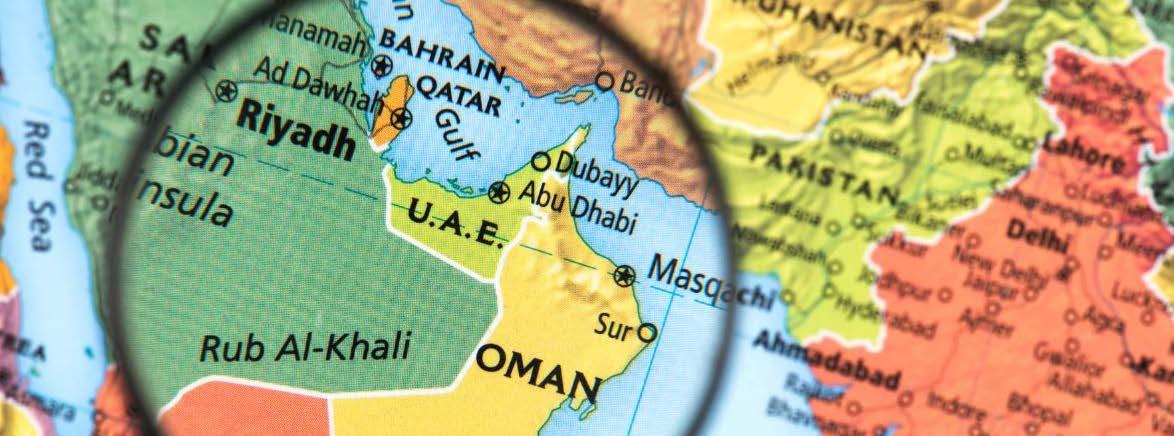
2 minute read
BAHRAIN
RB: Bahrain’s new parliament will bolster the government’s position over the coming months. However, the perception of the Shia population (around 60% of the population) being marginalised in political and economic terms will continue to be a source of latent political discontent. The stability of the Sunni Al Khalifa monarchy is largely guaranteed by the ongoing financial and military support from Saudi Arabia, which in turn is motivated largely by rival Iran’s expanding influence in the region.
Saudi Arabia, which is concerned about emboldening its own domestic Shia population, will likely ensure that Bahrain’s government refrains from granting meaningful political rights to its Shia communities. Bahraini-led government suppression of opposition leaders, activists, and protesters means that the threat of politically destabilising unrest is unlikely in the one-year outlook. The various security forces of Bahrain, including the Bahrain Defence Force, the National Guard, the National Security Agency, and the Ministry of Interior are overwhelmingly composed of Sunnis.
JM: Despite having a population of under two million, Bahrain boasts a thriving oil industry and has made a name for itself in the production of metals that rely heavily on fossil fuels. Its primary export is aluminium, valued at $7.1 billion in 2022 and predominantly shipped to the US, Saudi Arabia, and Turkey. The country’s second-largest export is oil and gas, worth $5.7 billion in 2022 and primarily sent to Japan, South Africa, Saudi Arabia, Singapore, and South Korea. Bahrain’s thirdlargest export is iron and steel, worth $1.4 billion.
Bahrain’s primary import is iron ore, and it is one of Brazil’s largest purchasers of the key ingredient for steel production. Additionally, the country imports machinery and electronics from China, cars from Japan and Germany, and ships from Saudi Arabia. In 2022, Bahrain’s total exports rose to $18.4 billion from $13.4 billion, with Saudi Arabia, the US, the UAE, the Netherlands, and Oman being its key export markets. Total imports also increased from $14.2 billion to $15.5 billion in 2022, with China, Brazil, Australia, the UAE, and the US being the primary sources of imports.
RB: Rising social discontent in Egypt is not expected to pose a threat to regime stability in the short term. It remains unlikely that growing economic grievances will stoke unruly demonstrations thanks to the high likelihood of security forces breaking up any unapproved gatherings. Since 2014, Egyptians have also had an overall lower appetite for large displays of popular unrest. In the meantime, Egypt has been severely affected by globally high food and fuel prices on its external account.
Egypt will continue to rely on its relations with regional neighbours over the medium term to ease the pressure on its external financial position. In October 2022, authorities reached an agreement with the International Monetary Fund (IMF) on a 46-month extended fund facility for $3 billion and have implemented a mix of monetary and fiscal measures. While the low-value loan is insufficient to resolve the crisis, additional sources of funding from Gulf countries are expected to act as an important buffer.

JM: Egypt, like Algeria, has taken advantage of Europe’s demand for energy following Russia’s incursion into Ukraine. Its primary export is oil and gas, which brought in $18.1 billion in revenue in 2022. Spain surpassed India as the largest fuel purchaser, with South Korea, Turkey, Italy, and China following close behind. Egypt’s second and fourth largest exports are plastics and fertilisers, both of which require significant amounts of fuel to produce. Additionally, Egypt is a major exporter of oranges, with sales totalling $683.7 billion in 2022.
Despite its robust export performance, Egypt maintains a trade deficit. It acquires clothing, electronics, and machinery from China, oil from Saudi Arabia, and soybeans from the US. If the regional economy continues to prosper, Egypt and other regional economic powers will likely continue to boost exports.
In 2022, total exports increased from $40.8 billion to $48.8 billion, with Turkey, Spain, Italy, Saudi Arabia, and the US being the primary markets. Imports, on the other hand, rose from $73 billion to $85.8 billion in 2022. The primary sources of imports were China, Saudi Arabia, the US, India, and Germany.










